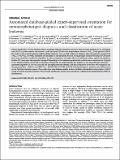Por favor, use este identificador para citar o enlazar a este item:
http://hdl.handle.net/10261/169311COMPARTIR / EXPORTAR:
 SHARE SHARE
 CORE
BASE CORE
BASE
|
|
| Visualizar otros formatos: MARC | Dublin Core | RDF | ORE | MODS | METS | DIDL | DATACITE | |

| Título: | Automated database-guided expert-supervised orientation for immunophenotypic diagnosis and classification of acute leukemia |
Autor: | Lhermitte, Ludovic; Mejstrikova, Ester; Sluijs-Gelling, Alita J. van der; Grigore, Georgiana Emilia; Sedek, Lukasz; Bras, A. E.; Gaipa, Giuseppe; Sobral da Costa, E.; Novákova, Michaela; Sonneveld, Edwin; Buracchi, Chiara; Bacelar, Thiago S.; Marvelde, Jeroen G. te; Trinquand, A.; Asnafi, V.; Szczepanski, Tomasz; Matarraz, Sergio; Lopez, A.; Vidriales, Maria Belén; Bulsa, J.; Hrusak, Ondrej; Kalina, Tomas; Lécrevisse, Quentin; Martín-Ayuso, Marta; Brüggemann, Monika; Verde, Javier; Fernandez, Paula; Burgos, Leire; Paiva, Bruno; Pedreira, C. E.; Dongen, J. J. M. van; Orfao, Alberto CSIC ORCID ; Velden, Vincent H. J. van der | Fecha de publicación: | 2018 | Editor: | Nature Publishing Group | Citación: | Leukemia 32(4): 874-881 (2018) | Resumen: | Precise classification of acute leukemia (AL) is crucial for adequate treatment. EuroFlow has previously designed an AL orientation tube (ALOT) to guide towards the relevant classification panel (T-cell acute lymphoblastic leukemia (T-ALL), B-cell precursor (BCP)-ALL and/or acute myeloid leukemia (AML)) and final diagnosis. Now we built a reference database with 656 typical AL samples (145 T-ALL, 377 BCP-ALL, 134 AML), processed and analyzed via standardized protocols. Using principal component analysis (PCA)-based plots and automated classification algorithms for direct comparison of single-cells from individual patients against the database, another 783 cases were subsequently evaluated. Depending on the database-guided results, patients were categorized as: (i) typical T, B or Myeloid without or; (ii) with a transitional component to another lineage; (iii) atypical; or (iv) mixed-lineage. Using this automated algorithm, in 781/783 cases (99.7%) the right panel was selected, and data comparable to the final WHO-diagnosis was already provided in >93% of cases (85% T-ALL, 97% BCP-ALL, 95% AML and 87% mixed-phenotype AL patients), even without data on the full-characterization panels. Our results show that database-guided analysis facilitates standardized interpretation of ALOT results and allows accurate selection of the relevant classification panels, hence providing a solid basis for designing future WHO AL classifications. | Versión del editor: | https://doi.org/10.1038/leu.2017.313 | URI: | http://hdl.handle.net/10261/169311 | DOI: | 10.1038/leu.2017.313 | Identificadores: | doi: 10.1038/leu.2017.313 e-issn: 1476-5551 issn: 0887-6924 |
| Aparece en las colecciones: | (IBMCC) Artículos |
Ficheros en este ítem:
| Fichero | Descripción | Tamaño | Formato | |
|---|---|---|---|---|
| autoleuk.pdf | 1,18 MB | Adobe PDF |  Visualizar/Abrir |
CORE Recommender
PubMed Central
Citations
18
checked on 21-abr-2024
SCOPUSTM
Citations
43
checked on 19-abr-2024
WEB OF SCIENCETM
Citations
41
checked on 25-feb-2024
Page view(s)
397
checked on 24-abr-2024
Download(s)
221
checked on 24-abr-2024

